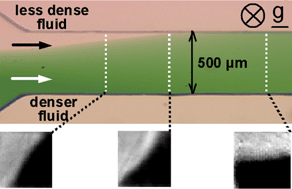Gravity-induced reorientation of the interface between two liquids of different densities flowing laminarly through a microchannel
Abstract
This paper experimentally quantifies the reorientation of the liquid–liquid interface between fluids of different densities flowing side-by-side in pressure-driven laminar flow in microchannels. A gravity-induced pressure mismatch at the interface will gradually drive the denser fluid to occupy the lower portion of the microchannel. The rate of this process is expected to depend on the interplay of viscous forces—which tend to dominate at the microscale—and inertial and gravitational forces. A correlation that relates the position of such a liquid–liquid interface to physical variables and channel dimensions was derived. The extent of reorientation of the streams was then related to two dimensionless numbers: Fr, the square root of the ratio of inertial to gravitational forces; and Re/Fr2, the ratio of gravitational to viscous forces. Further analysis showed that the reorientation of the streams depends only on the gravitational and viscous forces, but not inertia. The quantitative description of the position of the interface between liquids of different densities described in this paper aids in the rational design of the rapidly growing number of microchemical systems that utilize multistream laminar flow for performing spatially resolved chemistry and biology inside microfluidic channels.


 Please wait while we load your content...
Please wait while we load your content...